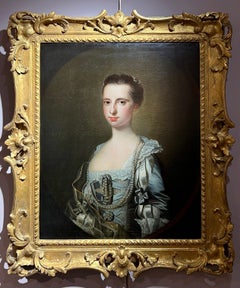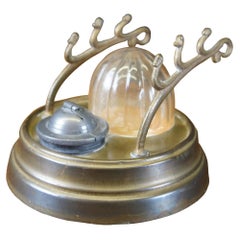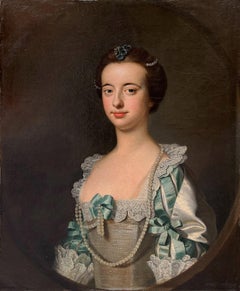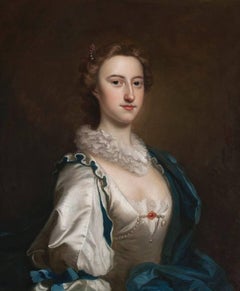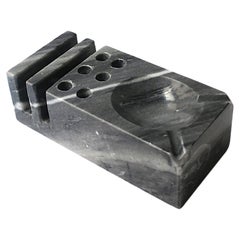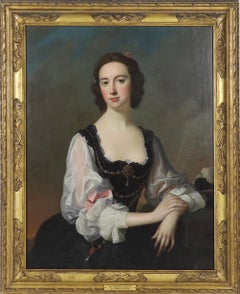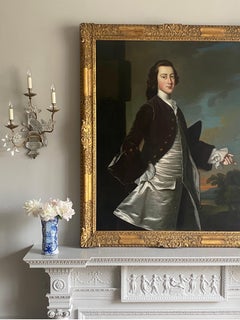Thomas Hudson Art
British, 1701-1779
Thomas Hudson (1701–1779) was an English painter, almost exclusively of portraits. Hudson was born in Devonshire in 1701.
His exact birthplace is unknown. He studied under Jonathan Richardson in London and, against the latter's wishes, married Richardson's daughter at some point before 1725.
Hudson was most prolific between 1740 and 1760 and, from 1745 until 1755 was the most successful London portraitist. He had many assistants, and employed the specialist drapery painter Joseph Van Aken.
Joshua Reynolds, Joseph Wright and the drapery painter Peter Toms were his students.
Hudson visited the Low Countries in 1748 and Italy in 1752.
In 1753 he bought a house at Cross Deep, Twickenham, just upstream from Pope's Villa.
He retired toward the end of the 1750s. William Hickey described the elderly Hudson, "His figure was rather grotesque, being uncommonly low in stature, with a prodigious belly, and constantly wearing a large white bushy periwig. He was remarkably good tempered, and one of my first-rate favourites, notwithstanding that he often told me I should certainly be hanged.".
He died at Twickenham in 1779. His extensive private art collection was sold off in three separate sales.
Many of Hudson's works may be seen in art galleries throughout the United Kingdom. They include the National Portrait Gallery, the National Maritime Museum, Tate, Barnstaple Guildhall, Foundling Museum and the Bristol City Museum and Art Gallery.to
1
3
1
3
3
1
Portrait of Lady Mansfield of Ringwood
By Thomas Hudson
Located in London, GB
Portrait of Lady Mansfield of Ringwood
Oil on Canvas, unsigned
Image size: 25 x 30 inches (63 x 76 cm)
Original carved & gilded frame
Provenance
Descended through the Family Estate
...
Category
18th Century English School Thomas Hudson Art
Materials
Canvas, Oil
Antique Victorian Thomas Hudson Barometric Ink Well Stand Pen Quill Holder 6"
By Thomas Hudson
Located in Dayton, OH
Antique 19th century library writing barometric / barometer pen holder and ink stand, Circa 1860s-1880s. Made of brass featuring pewter inkwell with glass dome reservoir and slots f...
Category
19th Century Victorian Antique Thomas Hudson Art
Materials
Brass, Pewter
$188 Sale Price
20% Off
Portrait of Lady Mansfield of Ringwood
By Thomas Hudson
Located in London, GB
Portrait of Lady Mansfield of Ringwood
Oil on Canvas, unsigned
Image size: 25 x 30 inches (63 x 76 cm)
Original carved & gilded frame
Provenance
Descended through the Family Estate
Born in Poland in 1760 to the 2nd Earl of Mansfield and his wife, Elizabeth Mary Murray would later come under the care of her uncle, William Murray (1st Earl of Mansfield) at Kenwood House in Hampstead. David Murray (2nd Earl of Mansfield) was set to inherit the title and full wealth of his uncle, including Kenwood House. Lady Mansfield’s second cousin would soon join her at Kenwood, where they would be raised together and featured in multiple portraits of the time. Her younger sister, Henrietta, is seen in a separate portrait done by Thomas Hudson as well. At the age of 25 she married George Finch-Hatton, an English aristocrat and politician who sat in the House of Commons from 1772-1784.
Gazing out at the viewer, Lady Mansfield wears a decorated dress, with an abundance of pearls and lace, and a transparent gold lined veil surrounding her right shoulder. The excess of luxurious fabric matches another Hudson portrait of another Lady Mansfield, with the lace detailing and complementary bodice. The depiction of this Lady Mansfield epitomizes the style of portraiture in the 18th century, such as the styles Hudson’s pupils Joshua Reynolds, Joseph Wright, and Peter Toms. From Hudson’s travels to the Low Countries and Italy, he no doubt brought back artistic inspiration from the international pieces he encountered.
Thomas Hudson
Hudson was a celebrated 18th century portrait painter. Born in Devon in 1701 he studied under the artist Jonathan Richardson and married his daughter, against Richardson’s wishes.
He had many artistic friends including William Hogarth and Francis Hayman and travelled with them in Europe in 1748. He also visited Italy with the sculptor Louis-François Roubiliac in 1752. Hudson’s style of portraiture proved so successful that for a decade from 1745 to 1755 he was London’s most popular portrait painter and made a fortune painting the cream of London society and members of the Royal Family.
He was also a talented teacher, perhaps too good, as subsequently a number of his former assistants overtook him in popularity including the artist Joshua Reynolds.
Hudson retired in the late 1750’s and died in Twickenham in 1779. His most notable works include portraits of King George II and George Friedrich Handel and his “Portrait of a Nobleman in Van Dyck dress.” Many of Hudson’s works may be seen in art galleries. These include the National Portrait Gallery, the National Maritime Museum, the Tate Gallery, the Foundling Museum and the Bristol City Museum and Art Gallery. His works are also in Museums across the world...
Category
18th Century English School Thomas Hudson Art
Materials
Canvas, Oil
Portrait of a Lady, Old Masters 18th Century Oil
By Thomas Hudson
Located in London, GB
Thomas Hudson
1701 – 1779
Portrait of a Lady
Oil on canvas
Image size: 30 x 25 inches
Original carved giltwood frame
Hudson had many assistants, and employed the specialist drapery ...
Category
18th Century Old Masters Thomas Hudson Art
Materials
Canvas, Oil
Related Items
Marble Desk Pen Holder Organizer
Located in New York, NY
A substantial marble desk pen/pencil/marker holder organizer, in the modern style, Midcentury Modern design period, circa mid-20th century. Organizer can hold small pieces of paper, ...
Category
Mid-20th Century Modern Thomas Hudson Art
Materials
Marble
Italian 18th Century Oval Religious Oil on Canvas Painting with Saint Dominic
By Francesco de Mura
Located in Firenze, IT
This beautiful Italian 18th Century old masters oil painting on oval canvas with giltwood frame is attributed to Solimena and features a religious scene.
In this splendid oval-shaped painting are depicted Saint Dominic...
Category
18th Century Old Masters Thomas Hudson Art
Materials
Canvas, Oil
$12,910
H 21.66 in Dm 15.75 in
Fine 1820's English Georgian Large Portrait of a Country Lady seated with Quill
Located in Cirencester, Gloucestershire
Portrait of a Country Lady, depicted Seated wearing a silk glove and with a Quill Pen
English artist, circa 1820's, unsigned
oil on canvas, unframed
canvas: 35 x 29 inches
provenance...
Category
Early 19th Century English School Thomas Hudson Art
Materials
Oil, Canvas
$2,669 Sale Price
30% Off
H 35 in W 29 in
Antique English Oil Painting Portrait of Pomeranian Dog 19th Century framed
Located in Cirencester, Gloucestershire
Portrait of a Pomeranian Dog
English artist, late 19th century
oil on canvas, framed
Framed: 14.5 x 12.5 inches
Canvas: 10 x 8 inches
Provenance: Private collection, Surrey, England
...
Category
Late 19th Century English School Thomas Hudson Art
Materials
Oil, Canvas
$1,545 Sale Price
30% Off
H 14.5 in W 12.5 in
Two royal portraits (the Duc d'Angoulême and the Duc de Berry) by H.P. Danloux
Located in PARIS, FR
These two royal portraits are a major historical testimony to the stay of the Comte d'Artois (the future Charles X) and his family in Edinburgh in 1796-1797. Given by the sitters to Lord Adam Gordon, the Governor of Edinburgh, and kept by family descent to this day, these two portraits provide us with a vivid and spontaneous image of the Duc d’Angoulême and his brother the Duc de Berry. Danloux, who had emigrated to London a few years before, demonstrate his full assimilation of the art of British portrait painters in the brilliant execution of these portraits.
1. Henri-Pierre Danloux, a portraitist in the revolutionary turmoil
Born in Paris in 1753, Henri-Pierre Danloux was first a pupil of the painter Nicolas-Bernard Lépicié (1735 - 1784) and then, in 1773, of Joseph-Marie Vien (1716 - 1809), whom he followed to Rome when, at the end of 1775, Vien became Director of the Académie de France. In Rome he became friends with the painter Jacques-Louis David (1748 - 1825).
Returning to France around 1782, he settled in Lyon for a few years before returning to Paris in 1785. One of his first portraits was commissioned by the Baroness d'Etigny, the widow of the former Intendant of the Provinces of Gascony, Bearn and Navarre Antoine Mégret d'Etigny (1719 – 1767). He then became close to his two sons, Mégret de Sérilly and Mégret d'Etigny, who in turn became his patrons. In 1787, this close relationship with the d'Etigny family was further strengthened by his marriage to Antoinette de Saint-Redan, a relative of Madame d'Etigny. After his marriage, he left for Rome and did not return to France until 1789. It was during the winter of 1790-1791 that he painted one of his masterpieces, the portrait of Baron de Besenval. Set in a twilight atmosphere, this portrait of an aristocrat who knows that his death is imminent symbolizes the disappearance of an erudite and refined society which would be swept away by the French Revolution.
The Jacobin excesses led Danloux to emigrate to England in 1792; many members of his family-in-law who remained in France were guillotined on 10 May 1794. Danloux enjoyed great success as a portrait painter in England before returning to France in 1801.
During his stay in England, Danloux was deeply under the influence of English portraitists: his colors became warmer (as shown by the portrait of the Duc d'Angoulême that we are presenting), and his execution broader.
2. Description of the two portraits and biographical details of the sitters
The Duc d'Angoulême (1775-1844) was the eldest son of the Comte d'Artois, the younger brother of King Louis XVI (the future King Charles X), and his wife Marie-Thérèse of Savoie. He is shown here, in the freshness of his youth, wearing the uniform of colonel-general of the "Angoulême-Dragons" regiment.
He is wearing the blue cordon of the Order of the Holy Spirit, which was awarded to him in 1787, and two decorations: the Cross of Saint-Louis and the Maltese Cross, as he was also Grand Prior of the Order of Malta.
Born on 16 August 1775 in Versailles, Louis-Antoine d'Artois followed his parents into emigration on 16 July 1789. In 1792, he joined the émigrés’ army led by the Prince de Condé. After his stay in Edinburgh (which will be further discussed), he went to the court of the future King Louis XVIII, who was in exile at the time, and in 1799 married his first cousin Marie-Thérèse Charlotte of France, the daughter of Louis XVI and the sole survivor of the royal family. The couple had no descendants. He became Dauphin of France in 1824, upon the accession to the throne of his father but played only a minor political role, preferring his military position as Grand Admiral. Enlisted in Spain on the side of Ferdinand VII, he returned home crowned with glory after his victory at Trocadero in 1823.
He reigned for a very short time at the abdication of Charles X in 1830, before relinquishing his rights in favor of his nephew Henri d'Artois, the Duc de Bordeaux. He then followed his father into exile and died on 3 June 1844 in Gorizia (now in Italy).
His younger brother, the Duc de Berry, is shown in the uniform of the noble cavalry of the émigrés’ Army. He is wearing the blue cordon of the Order of the Holy Spirit, awarded to him in May 1789, and the Cross of Saint-Louis (partly hidden by his blue cordon).
Born on 24 January 1778 in Versailles, Charles-Ferdinand d'Artois also followed his parents into emigration and joined the émigrés’ army in 1792. After his stay in Edinburgh, he remained in Great Britain, where he had an affair with Amy Brown...
Category
1790s Old Masters Thomas Hudson Art
Materials
Canvas, Oil, Wood Panel
Male and female portrait, both in silk kimono, possibly textile dealers
By Christoffel Lubieniecki
Located in Amsterdam, NL
CHRISTOFFEL LUBIENIECKI (1659-1729)
Pair of portraits of a gentleman and a lady, both in silk kimono, before a country house (circa 1680)
Indistinctly signed “C.......” on a box under the man’s left hand
Oil on canvas, 79.5 x 67 cm each
Both sitters are portrayed wearing a silk “Japanese” coat. During the second half of the seventeenth the Japanese silk coat, an adapted Japanese kimono, became a real vogue in the Dutch elite. The exclusive Dutch trade contacts with Japan can explain the popularity of the kimono-style silk coats in the Netherlands. Everybody who could afford one, dressed in such a fashionable and comfortable coat and, like the present sitters, some proud owners had themselves portrayed in a “Japanese” coat often together with an oriental carpet to underline their standing and international connections. These portraits are the work of the Polish-born portraitist Christoffel Lubieniecki (also known as Lubienitski, Lubinitski or Lubiniecki)
Lubieniecki was first trained in Hamburg under Julian Stuhr and after 1675 in Amsterdam under Adriaen Backer and Gerard de Lairesse. He specialized in landscapes, generally of an Italianate character, and in portraits. The loving execution of these contented burghers, enjoying the garden vistas of their country house, places him alongside Amsterdam portraitists such as Constantijn Netscher and Michiel van Musscher...
Category
1680s Old Masters Thomas Hudson Art
Materials
Canvas, Oil
$37,558
H 31.34 in W 26.38 in D 1.97 in
Staffordshire Dalmatian Pen Holder, Circa 1960's
Located in High Point, NC
Vintage 1960's pen holder in the form of a Dalmatian made in the Staffordshire region of England. The Dalmatian is recumbent, with front legs crossed in an elegant fashion, and sitt...
Category
1960s English Victorian Vintage Thomas Hudson Art
Materials
Ceramic
Fine Large 1800's English Oil Country Gentleman in Parkland before Stately Home
Located in Cirencester, Gloucestershire
The English Gentleman and his Country House
English artist, circa 1800-1820 period
Fine Georgian period portrait of a young English gentleman, seated with distant view of his country...
Category
Early 19th Century English School Thomas Hudson Art
Materials
Oil, Canvas
$2,669 Sale Price
30% Off
H 36 in W 28 in
Montblanc fountain pen holder.
By Montblanc
Located in Lugo, IT
Montblanc fountain pen holder.
With refill.
Good condition.
Thank you.
Category
1960s Modern Vintage Thomas Hudson Art
Materials
Plastic
19th Century By Giuseppe Molteni Portrait of a Woman Oil on Canvas
Located in Milano, Lombardia
Giuseppe Molteni (Affori (Milano), Italy, 1800 - Milano, Italy, 1867)
Title: Portrait of a Woman
Medium: Oil on canvas
Dimensions: without frame 67 × 55 cm - with frame 91.5 x 80 cm
...
Category
19th Century Old Masters Thomas Hudson Art
Materials
Oil, Canvas
$26,009 Sale Price
20% Off
H 26.38 in W 21.66 in D 1.97 in
1830's British Oil Painting Large Portrait of a Distinguished Gentleman
Located in Cirencester, Gloucestershire
Portrait of an English Gentleman
English School, circa 1830's period
oil on canvas, unframed
Canvas: 30 x 24.5 inches
Provenance: Private collection, UK
Condition: relined canvas, ov...
Category
Early 19th Century English School Thomas Hudson Art
Materials
Oil, Canvas
$1,545 Sale Price
30% Off
H 30 in W 24.5 in
Antique Late 19th Century English Oil on Canvas Painting Female Portrait 1900
Located in Portland, OR
Antique English oil on canvas portrait painting, circa 1900. A very handsome Impressionist portrait of a youthful lady in Edwardian dress. Oil on canvas, signed to the upper left "F ...
Category
Early 1900s English School Thomas Hudson Art
Materials
Canvas, Oil
$1,900
H 33.25 in W 29.5 in D 2 in
Previously Available Items
18th century portrait of Miss Furneaux-Pelham
By Thomas Hudson
Located in Bath, Somerset
Portrait of a Miss Furneaux Pelham, in a 'Van Dyck' style black gown with white sleeves trimmed with pink ribbon, the bodice adorned with jewels and pearls, resting her arm on a stone pedestal.
Bears a Christie's stencil on the reverse 629HT and a Sotheby's auction chalk mark.
Oil on canvas housed in a period giltwood frame.
Canvas size: 92 x 71cm
In frame: 109 x 89cm
Provenance:
Property of Edward Hockley when sold at Christie's London, 3 May 1946, lot 79 (as by Allan Ramsay), bt. by 'Nicholl'
Sotheby's London sale, 'British Paintings 1500-1805', 10 July 1991, lot 22 (as by Thomas Hudson)
Private collection, Sussex
From 1740 to about 1760 Thomas Hudson was one of the most successful portrait painters in England. Having come to London in the mid-1720's, shortly after the death of Sir Godfrey Kneller in 1723, Hudson gradually rose to a position of prominence, which he held until the 1750's. Hudson painted only portraits, working first under the influence of his teacher Jonathan Richardson, and then turning in the 1740's to the baroque portrait compositions of Sir Anthony Van Dyck and Sir Peter Lely. From this time, with the assistance of drapery painters such as Joseph Van Aken, Hudson produced large numbers of portraits of ladies, gentlemen, judges and clergymen.
He married his teacher's daughter Mary...
Category
18th Century English School Thomas Hudson Art
Materials
Canvas, Oil
English 18th century portrait of Walter Edwards Freeman (c.1725-1747)
By Thomas Hudson
Located in Bath, Somerset
Walter Edwards Freeman, three-quarter length, standing in a landscape (probably the grounds of Batsford Park) wearing a dark green velvet jacket with gold buttons and a white cravat, an ivory silk waistcoat with his hat tucked under his arm, his hair worn 'en queue'. Oil on canvas.
Walter Edwards Freeman (born circa 1725) was the son of Mary (nee Freeman) and Walter Edwards Senior whose family came from Bristol. Mary's father was Richard Freeman (Senior), a landowner with extensive properties in several counties and was appointed Lord Chancellor of Ireland in 1702. After the death of his uncle, Richard Freeman (the Younger) in 1745, he inherited the estate of Batsford Park, Gloucestershire, and he and his family took the surname Freeman. Sadly Walter died two years later and his brother Thomas then inherited the Batsford Estate. When Thomas died without a direct heir in 1808, the estate passed on to his wife's nephew John Mitford and so on through the Mitford family. In 1916 it was inherited by the eccentric David Freeman-Mitford, 2nd Baron Redesdale and father of the famous Mitford sisters. His eldest daughter, Nancy Mitford, based part of her novels 'The Pursuit of Love' and 'Love in a Cold Climate' on their time living at Batsford.
Provenance:
The property of a Mrs E. Redburn when sold with Sotheby's London, 23 November 1977
With Lane Fine Art, London
The property of Eric Dare, Melbourne, Australia when sold with Sotheby's, 13 November 1995.
Christie's London, British Pictures, 24 November, 1998, lot 27
From 1740 to about 1760 Thomas Hudson was one of the most successful portrait painters in England. Having come to London in the mid-1720's, shortly after the death of Sir Godfrey Kneller in 1723, Hudson gradually rose to a position of prominence, which he held until the 1750's. Hudson painted only portraits, working first under the influence of his teacher Jonathan Richardson, and then turning in the 1740's to the baroque portrait compositions of Sir Anthony Van Dyck and Sir Peter Lely. From this time, with the assistance of drapery painters such as Joseph Van Aken, Hudson produced large numbers of portraits of ladies, gentlemen, judges and clergymen. He married his teacher's daughter Mary Richardson...
Category
Mid-18th Century English School Thomas Hudson Art
Materials
Canvas, Oil
Portrait of an Aristocratic Gentleman in Crimson Velvet Jacket Oil Painting
By Thomas Hudson
Located in Cirencester, Gloucestershire
Portrait of an Aristocratic Gentleman
attributed to Thomas Hudson (British 1701-1779)
oil painting on canvas, framed
canvas: 30 x 25 inches
framed: 33 x 28 inches
provenance: private collection, England
Fine 18th century English oil painting...
Category
18th Century Old Masters Thomas Hudson Art
Materials
Canvas, Oil
English 18th century Portrait of a Lady wearing blue silk
By Thomas Hudson
Located in Bath, Somerset
A rare signed portrait of a young lady by Thomas Hudson (1701-1779) circa 1736. Inscribed lower right 'D.G. 18 years' and signed 'Hudson'.
Size 41½” x 31” (105.5 x 79 cms)
Oil on c...
Category
Early 18th Century Old Masters Thomas Hudson Art
Materials
Oil, Canvas
H 41.54 in W 31.11 in
Thomas Hudson - Pair of portraits - 4th Duke of Beauforts children
By Thomas Hudson
Located in Stoke, Hampshire
Thomas Hudson 1701-1779
The eldest children of Charles Noel, 4th Duke of Beaufort: Head and shoulders portraits of Henry (1744-1803; later 5th Duke) a little boy dressed in blue Van Dyck costume, and his sister Lady Anne Somerset, (1741-1763) in a white dress set with pink ribbons, and a lace ruff.
Oil paintings on canvas each 20 x 15 inches in carved and giltwood frames
Painted circa 1747/8
Thomas Hudson, a native of Devon, was by far the leading portrait painter in London for two decades in the middle years of the 18th century. He had arrived in London in the 1720’s after the death of Sir Godfrey Kneller, who had dominated London society portraiture for decades. He was taught to paint portraits by the redoubtable Jonathan Richardson, the artist, connoisseur, collector and theoretician of the arts.
His portrait practice by 1740 was substantial and highly successful, and numerous paintings by him survive. He continued the tradition of Van Dyck and Lely, and maintained a large studio with numerous talented young artists whom he taught: Henry Pickering, Joseph Wright of Derby, Sir Joshua Reynolds and others. He usually employed Joseph Van Aken as his drapery painter, and the consequence is that many of the works of these artists in these two decades are often difficult to distinguish one from another.
His quality, though, is consistent, and his likenesses truthful: they are the sound Georgian Prose and may be contrasted with the feathery rococo poetry of painters of the next generation, most notably Gainsborough.
The present paintings illustrate the high fashion of the 1750-60's, when the “Van Dyck” falling lace collar enjoyed a substantial, if rather brief, popularity. Hudson used the style on numerous occasions for both male and female sitters. The present pictures are autograph replicas of two of the group of portraits by Hudson of the 4th Duke's children painted towards the end of the 1740's, and which remain at Badminton House...
Category
18th Century Thomas Hudson Art
Materials
Oil
Thomas Hudson art for sale on 1stDibs.
Find a wide variety of authentic Thomas Hudson art available for sale on 1stDibs. You can also browse by medium to find art by Thomas Hudson in canvas, fabric, oil paint and more. Much of the original work by this artist or collective was created during the 18th century and earlier and is mostly associated with the Old Masters style. Not every interior allows for large Thomas Hudson art, so small editions measuring 25 inches across are available. Customers who are interested in this artist might also find the work of John Emms, W. Smithson Broadhead, and John Horace Hooper. Thomas Hudson art prices can differ depending upon medium, time period and other attributes. On 1stDibs, the price for these items starts at $24,293 and tops out at $25,307, while the average work can sell for $24,540.
